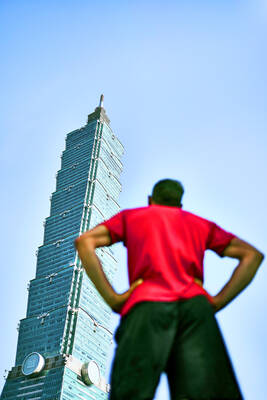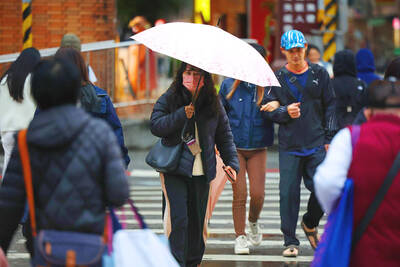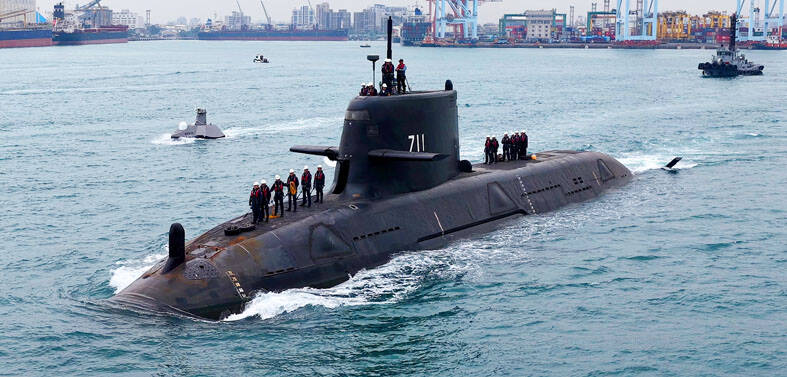A senior US military officer is to privately brief a US congressional subcommittee on how a new weapons system could be used in the Taiwan Strait.
The system involves heavily armed surveillance drones that would fly from aircraft carriers to counter Chinese anti-ship missiles.
“If these unmanned platforms can keep the US Navy carrier battle groups relevant in the face of new Chinese threats, that will benefit Taiwan tremendously,” said Richard Fisher, senior fellow on Asian military affairs at the International Assessment and Strategy Center.
The US House of Representatives’ Seapower and Projection Forces Subcommittee called a hearing on the drones — officially known as Unmanned Carrier Launched Surveillance and Strike (UCLASS) — earlier this month.
Subcommittee Chairman Randy Forbes said the UCLASS program was “integral to ensuring our carrier fleet can continue to project power throughout the globe.”
Forbes asked one of the witnesses, Pentagon-based Brigadier General Joseph Guastella, if the UCLASS drones could operate over areas guarded by Chinese warships.
Guastella answered that the capabilities of Chinese surface action groups had been considered and that he would be “happy to come by and show you what that exactly entails, what that threat is, where that threat is located.”
Forbes responded: “And when you do, could you also talk about the Taiwan Strait and how it would operate there?”
“Yes sir, I would be happy to do that,” Guastella said.
No details on how the UCLASS drones would deal with Chinese warships were given in the open hearing and are presumably classified.
However, it is known that prototype UCLASS drones have been landed on aircraft carriers and that the plan is to use them in the future for intelligence gathering, surveillance, reconnaissance, targeting and strike capability.
Four major US companies are now competing for the UCLASS development and production contract.
One proposal is for the drone to carry a 1,000-pound (453.6kg) Laser Joint Attack Munition and be operational by about 2020.
“The US is in an arms race,” Fisher told the Taipei Times.
He said that last year, the US Navy had to revise UCLASS requirements, decreasing stealth capabilities in exchange for larger size and range.
“The UCLASS technology demonstration vehicle, the Northrop-Grumman X-47B, has an estimated combat radius of about 1,900km, which may have been too close to the estimated 1,700km range of the PLA’s [China’s People’s Liberation Army] DF-21D anti-ship ballistic missile,” Fisher said.
The UCLASS that should be entering service in about six years will be larger and have a longer range.
“These platforms could eventually be armed with high-power lasers to perform missile defense and anti-satellite missions,” Fisher said.
However, he stressed that reliance on unmanned platforms carries clear risks.
They are vulnerable to enemy electronic interference and “insider” threats.
Fisher said that absent appropriate countermeasures, one traitor with deep inside knowledge on a flash drive could in seconds turn the US’ unmanned air force into the PLA’s unmanned air force.
He said the next step for the US may be to develop UCLASS size platforms that are also capable of sustained high supersonic speeds to better counter long-range PLA missiles and eventual PLA long-range drones.

US climber Alex Honnold is to attempt to scale Taipei 101 without a rope and harness in a live Netflix special on Jan. 24, the streaming platform announced on Wednesday. Accounting for the time difference, the two-hour broadcast of Honnold’s climb, called Skyscraper Live, is to air on Jan. 23 in the US, Netflix said in a statement. Honnold, 40, was the first person ever to free solo climb the 900m El Capitan rock formation in Yosemite National Park — a feat that was recorded and later made into the 2018 documentary film Free Solo. Netflix previewed Skyscraper Live in October, after videos

NUMBERS IMBALANCE: More than 4 million Taiwanese have visited China this year, while only about half a million Chinese have visited here Beijing has yet to respond to Taiwan’s requests for negotiation over matters related to the recovery of cross-strait tourism, the Tourism Administration said yesterday. Taiwan’s tourism authority issued the statement after Chinese-language daily the China Times reported yesterday that the government’s policy of banning group tours to China does not stop Taiwanese from visiting the country. As of October, more than 4.2 million had traveled to China this year, exceeding last year. Beijing estimated the number of Taiwanese tourists in China could reach 4.5 million this year. By contrast, only 500,000 Chinese tourists are expected in Taiwan, the report said. The report

Temperatures are forecast to drop steadily as a continental cold air mass moves across Taiwan, with some areas also likely to see heavy rainfall, the Central Weather Administration (CWA) said. From today through early tomorrow, a cold air mass would keep temperatures low across central and northern Taiwan, and the eastern half of Taiwan proper, with isolated brief showers forecast along Keelung’s north coast, Taipei and New Taipei City’s mountainous areas and eastern Taiwan, it said. Lows of 11°C to 15°C are forecast in central and northern Taiwan, Yilan County, and the outlying Kinmen and Lienchiang (Matsu) counties, and 14°C to 17°C

STEERING FAILURE: The first boat of its class is experiencing teething issues as it readies for acceptance by the navy, according to a recent story about rudder failure The Hai Kun (海鯤), the nation’s first locally built submarine, allegedly suffered a total failure of stern hydraulic systems during the second round of sea acceptance trials on June 26, and sailors were forced to manually operate the X-rudder to turn the submarine and return to port, news Web site Mirror Daily reported yesterday. The report said that tugboats following the Hai Kun assisted the submarine in avoiding collisions with other ships due to the X-rudder malfunctioning. At the time of the report, the submarine had completed its trials and was scheduled to begin diving and surfacing tests in shallow areas. The X-rudder,